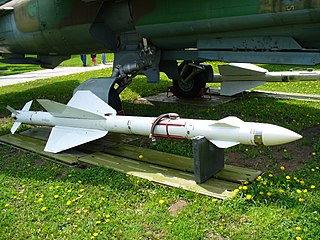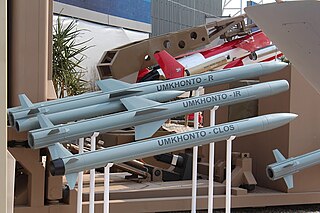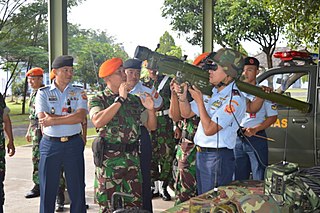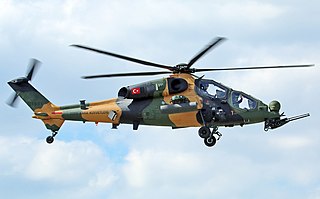
The General Atomics MQ-1 Predator is an American remotely piloted aircraft (RPA) built by General Atomics that was used primarily by the United States Air Force (USAF) and Central Intelligence Agency (CIA). Conceived in the early 1990s for aerial reconnaissance and forward observation roles, the Predator carries cameras and other sensors. It was modified and upgraded to carry and fire two AGM-114 Hellfire missiles or other munitions. The aircraft entered service in 1995, and saw combat in the war in Afghanistan, Pakistan, the NATO intervention in Bosnia, 1999 NATO bombing of Yugoslavia, the Iraq War, Yemen, the 2011 Libyan civil war, the 2014 intervention in Syria, and Somalia.

The Boeing AH-64 Apache is an American twin-turboshaft attack helicopter with a tailwheel-type landing gear arrangement and a tandem cockpit for a crew of two. It features a nose-mounted sensor suite for target acquisition and night vision systems. It is armed with a 30 mm (1.18 in) M230 chain gun carried between the main landing gear, under the aircraft's forward fuselage, and four hardpoints mounted on stub-wing pylons for carrying armament and stores, typically a mixture of AGM-114 Hellfire missiles and Hydra 70 rocket pods. The AH-64 has significant systems redundancy to improve combat survivability.

The FIM-92 Stinger is a man-portable air-defense system (MANPADS) that operates as an infrared homing surface-to-air missile (SAM). It can be adapted to fire from a wide variety of ground vehicles and helicopters. Developed in the United States, it entered service in 1981 and is used by the militaries of the United States and 29 other countries. It is principally manufactured by Raytheon Missile Systems and is produced under license by EADS in Germany and by ROKETSAN in Turkey, with 70,000 missiles produced.

The Agusta A129 Mangusta is an attack helicopter originally designed and produced by Italian company Agusta. It is the first attack helicopter to be designed and produced wholly in Europe. It has continued to be developed by AgustaWestland, the successor company to Agusta. The A129 has undergone several combat deployments since entering service with the Italian Army in the 1990s.

The RIM-116 Rolling Airframe Missile (RAM) is a small, lightweight, infrared homing surface-to-air missile in use by the German, Japanese, Greek, Turkish, South Korean, Saudi Arabian, Egyptian, Mexican and U.S. Navies. It was intended originally and used primarily as a point-defense weapon against anti-ship cruise missiles. As its name indicates, RAM rolls as it flies. The missile must roll during flight because the RF tracking system uses a two-antenna interferometer that can measure phase interference of the electromagnetic wave in one plane only. The rolling interferometer permits the antennas to look at all planes of incoming energy. In addition, because the missile rolls, only one pair of steering canards is required. As of 2005, it is the only U.S. Navy missile to operate in this manner.

Fire-and-forget is a type of missile guidance which does not require further guidance after launch such as illumination of the target or wire guidance, and can hit its target without the launcher being in line-of-sight of the target. This is an important property for a guided weapon to have, since a person or vehicle that lingers near the target to guide the missile is vulnerable to attack and unable to carry out other tasks.

The Vympel R-23 is a medium-range air-to-air missile developed by Vympel in the Soviet Union for fighter aircraft. An updated version with greater range, the R-24, replaced it in service. It is comparable to the American AIM-7 Sparrow, both in terms of overall performance as well as role.

The Avenger Air Defense System, designated AN/TWQ-1 under the Joint Electronics Type Designation System, is an American self-propelled surface-to-air missile system which provides mobile, short-range air defense protection for ground units against cruise missiles, unmanned aerial vehicles, low-flying fixed-wing aircraft, and helicopters.

Man-portable air-defense systems are portable surface-to-air missiles. They are guided weapons and are a threat to low-flying aircraft, especially helicopters.

The General Dynamics FIM-43 Redeye is a man-portable surface-to-air missile system. It uses passive infrared homing to track its target. Production began in 1962 and – in anticipation of the Redeye II, which later became the FIM-92 Stinger – ended in the early 1970s after about 85,000 rounds had been built. The Redeye was withdrawn gradually between 1982 and 1995 as the Stinger was deployed, though it remained in service with various armed forces of the world until quite recently, being supplied via the Foreign Military Sales program. It was initially banned from being sold overseas, to avoid missiles falling into the hands of terrorist organizations. However, after the export ban was lifted, the weapon was never actually used by terrorists against civil aircraft, in contrast with other MANPADS. While the Redeye and 9K32 Strela-2 (SA-7) were similar, the missiles weren’t identical. Nonetheless, the CIA concluded that the Soviet SA-7 had benefited from the Redeye’s development.

The MIM-72A/M48 Chaparral is an American self-propelled surface-to-air missile system based on the AIM-9 Sidewinder air-to-air missile system. The launcher is based on the M113 family of vehicles. It entered service with the United States Army in 1969 and was phased out between 1990 and 1998. It was intended to be used along with the M163 VADS, the Vulcan ADS covering short-range short-time engagements, and the Chaparral for longer range use.

The Umkhonto is a South African family of modern short- to medium-range, all-weather-capable vertical launch (VLS) surface-to-air missiles (SAM) manufactured by South Africa's Denel Dynamics. The missile and associated subsystems are supplied as a missile group for easy integration into naval combat suites or ground-based air defence systems.

The People's Republic of China-developed QW-1 Vanguard is an all-aspect man-portable surface-to-air missile, from which a series of missiles were developed.

The Mitsubishi AAM-5 is a short-range air-to-air missile developed and produced by Mitsubishi Heavy Industries for the Japan Air Self-Defense Force. Development of the missile as a replacement for the AAM-3 missile commenced in 1991 and it has been operational since 2004.

The AGM-176 Griffin is a lightweight, precision-guided munition developed by Raytheon. It can be launched from the ground or air as a rocket-powered missile or dropped from the air as a guided bomb. It carries a relatively small warhead, and was designed to be a precision low-collateral damage weapon for irregular warfare. It has been used in combat by the United States military during the War in Afghanistan.

UMTAS or Mizrak-U(Uzun Menzilli Tanksavar Sistemi) is a modern long range air-to-surface anti-tank missile developed by Turkish armor and missile manufacturer ROKETSAN.

United States Army air defense relies on a range of ground launched missiles ranging from hand held to vehicle mounted systems. The Air Defense Artillery is the branch that specializes in anti-aircraft weapons. In the US Army, these groups are composed of mainly air defense systems such as the PATRIOT Missile System, Terminal High Altitude Air Defense, and the Avenger Air Defense system which fires the FIM-92 Stinger missile.

The TAI/AgustaWestland T129 ATAK is a twin-engine, tandem seat, multi-role, all-weather attack helicopter based on the Agusta A129 Mangusta platform. The T129 was developed by Turkish Aerospace Industries (TAI) with partner AgustaWestland. The helicopter is designed for advanced attack and reconnaissance missions in hot and high environments and rough geography in both day and night conditions.

The Joint Ground-based Air Defence Command is a joint command of the Royal Netherlands Army, formed in 2012 after amalgamation of the Commando Luchtdoelartillerie of the Royal Netherlands Army and the Groep Geleide Wapens of the Royal Netherlands Air Force. The command is responsible for all ground-based air defence tasks and consists of both army and air force personnel. The DGLC employs an integrated layered air-defence approach featuring FIM-92 Stinger, NASAMS II and MIM-104 Patriot systems.

The TAI T929 ATAK 2 is a twin-engine, heavy attack helicopter under development by Turkish Aerospace Industries. The helicopter is designed for attack, electronic warfare and reconnaissance missions in all-weather environments in both day and night conditions.




















